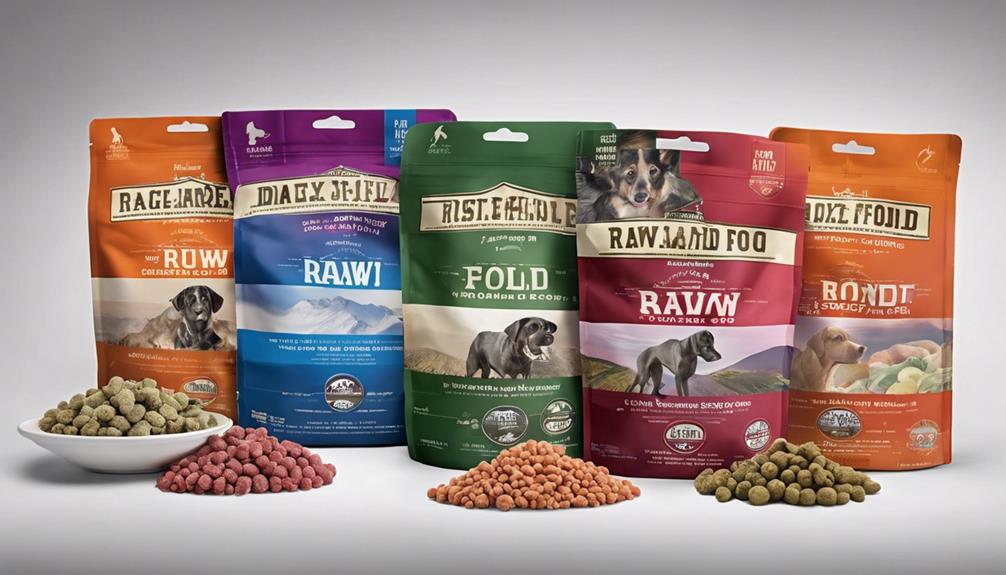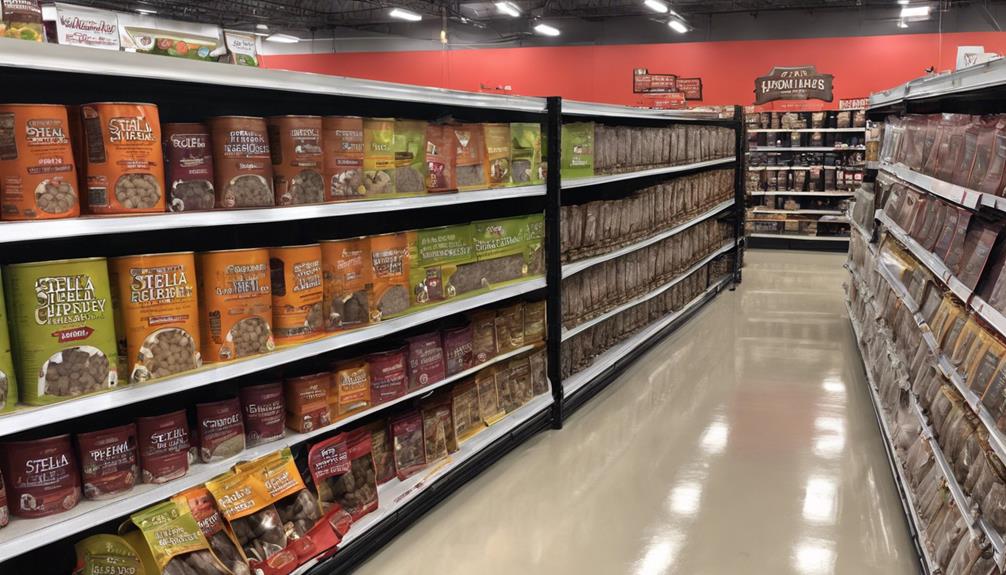Freeze-dried raw dog food is an excellent option for pet parents looking for high-quality nutrition and convenience. This choice replicates a natural diet, safeguarding essential nutrients and ensuring easy digestion, making it perfect for sensitive stomachs. The convenient and lightweight nature of freeze-dried raw food, combined with its easy portion control and space-saving features, makes it ideal for travel.
However, it's crucial to weigh the potential higher cost and limited availability when pondering the pros and cons of this diet choice. The intense flavor and aroma of raw meats can enhance your dog's mealtime enjoyment and overall health. Making an informed decision based on your pet's specific needs and preferences is vital to their well-being.
Key Takeaways
- Mimics natural diet for better health and wellness.
- Easily digestible with retained enzymes and nutrients.
- Higher cost justified by quality ingredients.
- Limited availability may require research and exploration.
- Ideal for sensitive stomachs and picky eaters.
Nutrient-Rich Option
Freeze-dried raw dog food offers a nutrient-rich option that closely mimics a dog's natural diet, promoting peak health and well-being. This type of food is minimally processed, guaranteeing that essential nutrients like proteins, vitamins, and minerals are preserved, providing high nutritional value for your furry friend.
By offering a diet that's rich in nutrients, freeze-dried raw dog food can address specific dietary needs, supporting peak health and wellness for your dog. The nutrient density in this food can help enhance various aspects of your dog's health, such as digestion, immune function, and energy levels.
Choosing freeze-dried raw dog food can be a beneficial way to make sure that your pet receives the necessary nutrients to thrive and lead a healthy life. It's a simple yet effective way to provide your dog with a diet that promotes their overall well-being and vitality.
Improved Digestive Health

Switching to freeze-dried raw dog food can greatly improve your furry friend's digestive health because of its easily digestible nature and gentle impact on the stomach. The minimal processing of freeze-dried raw food retains enzymes and nutrients, aiding in digestion. Dogs with sensitive stomachs or food allergies may benefit from the improved digestibility of freeze-dried raw dog food.
Here are three reasons why freeze-dried raw dog food is beneficial for digestive health:
- Easily Digestible: The gentle processing of freeze-dried raw dog food makes it easier for dogs to digest, reducing the likelihood of gastrointestinal issues.
- Nutrient-Rich: The retention of essential enzymes and nutrients in freeze-dried raw food supports better nutrient absorption in dogs, contributing to overall wellness.
- Ideal for Sensitive Stomachs: Dogs with sensitive stomachs or food allergies can find relief in freeze-dried raw dog food, as it's less likely to trigger digestive issues.
Making the switch to freeze-dried raw dog food can lead to improved digestive health and a happier, healthier pet.
Lightweight and Convenient
Carrying freeze-dried raw dog food for travel or outdoor activities is a breeze due to its lightweight and convenient nature. This type of dog food is perfect for pet owners who follow a raw diet but need a portable option. Its lightweight design makes it easy to pack for travel, hiking, or camping adventures.
The convenience of freeze-dried raw dog food extends to its easy portion control, allowing you to feed your furry companion without any hassle. Additionally, the compact size of this food saves valuable storage space compared to traditional raw meat options.
Whether you're starting on outdoor adventures or simply on-the-go, the portability of freeze-dried raw dog food guarantees that your pet's nutritional needs are met without any added stress. So, next time you're planning a trip or a hike, consider the convenience and practicality of incorporating lightweight freeze-dried raw dog food into your furry friend's diet.
Potential Higher Cost

While freeze-dried raw dog food offers premium quality ingredients, the potential higher cost may pose a challenge for some pet owners. When contemplating investing in freeze-dried dog food, it's crucial to evaluate the benefits against the pricing to make an informed decision. Here are some key points to ponder:
- Quality Ingredients: The higher cost is justified by the superior quality ingredients used in freeze-dried raw food, ensuring your furry friend receives excellent nutrition.
- Brand and Processing Methods: Pricing can vary depending on the brand and processing techniques employed. Some brands may use more costly ingredients or intricate processing methods, impacting the final cost.
- Limiting Factor for Some Pet Owners: The cost of freeze-dried raw dog food may be a constraining factor for some pet owners. While the initial investment might be higher, many pet owners believe the long-term health benefits outweigh the upfront expenses.
Ultimately, comprehending the pricing factors and benefits associated with freeze-dried raw dog food can help pet owners make the best choice for their furry companions.
Limited Availability
Limited availability of freeze-dried raw dog food can pose challenges for pet owners, especially when seeking specific brands or flavors. Supply constraints may result in limited options at local stores, prompting some to explore online retailers or specialty pet shops for a broader selection.
It's advisable to research various suppliers to guarantee access to the desired freeze-dried options for your furry companion.
Availability Challenges
Finding freeze-dried raw dog food options can be a challenge due to limited availability in certain areas or stores. When facing availability challenges, consider these key points:
- Explore Specialized Pet Stores: These stores often carry a wider selection of freeze-dried raw dog food options, making it easier to find specific brands or flavors.
- Check Online Retailers: Online platforms offer convenience and a broader range of choices, helping overcome limited availability in local stores.
- Consider Location Differences: Availability can vary based on location and demand, so exploring different sources or online options may be necessary to access a variety of freeze-dried raw dog food.
Navigating these challenges can ensure your furry friend enjoys a diverse and balanced diet.
Supply Constraints
Handling supply constraints for freeze-dried raw dog food can pose challenges for pet owners seeking specific brands or varieties. Due to specialized production processes, some niche brands of freeze-dried raw dog food may be harder to find, leading to potential supply constraints. Certain varieties might only be available through specific retailers, making them less accessible to consumers.
The demand for freeze-dried raw dog food sometimes surpasses the supply, resulting in occasional shortages in the market. It's crucial for pet owners to be aware of these limitations when shopping for freeze-dried raw dog food to guarantee they can find the products they desire for their furry companions.
Transition Challenges

During the shift to freeze-dried raw dog food, it's important to monitor your pet's reaction closely to guarantee a smooth adjustment process. Here are some key points to ponder when facing change challenges:
- Gradual Shift: Introduce freeze-dried raw food slowly to prevent digestive upset and refusal.
- Monitoring Health: Keep an eye on your dog's stool consistency and overall well-being during the adjustment period.
- Consult with a Veterinarian: Seek guidance from a professional to make sure a successful shift to freeze-dried raw food.
Enhanced Palatability

Freeze-dried raw dog food is known for enhancing palatability through the preservation of natural flavors and textures. This process retains the aroma and taste of raw meat, making it more enticing for dogs.
Enhanced palatability can be especially beneficial for picky eaters, improving their mealtime enjoyment and encouraging better eating habits.
Taste Preference Enhancement
To enhance a dog's taste preferences, freeze-dried raw dog food preserves natural flavors and textures, making it more appealing than heavily processed alternatives. When considering taste preference enhancement with freeze-dried raw food, the following points are crucial:
- Maintains Natural Flavors: Freeze-dried raw food upholds the authentic taste of real meat, enticing dogs with its natural flavors.
- Texture Preservation: The minimal processing guarantees that freeze-dried raw food retains its original textures, satisfying even picky eaters.
- Aroma Appeal: The enticing scent of freeze-dried raw food adds to the overall palatability, making mealtime more enjoyable for dogs.
These factors collectively contribute to the improved palatability of freeze-dried raw dog food, enriching the mealtime experience for our furry companions.
Improves Mealtime Enjoyment
Enhanced palatability in dog food often leads to increased enjoyment during mealtime for our furry companions. Freeze-dried raw dog food offers a delightful mix of natural flavors and textures that dogs find highly appealing. The minimal processing involved in freeze-dried raw food preserves its taste and aroma, making it enticing for even the choosiest eaters. This enhanced palatability stimulates a dog's appetite, turning mealtime into exciting moments of anticipation. As a result, dogs are more likely to devour their meals enthusiastically, leading to overall satisfaction. Providing such exciting meals not only benefits picky eaters but also enhances the mealtime experience for all dogs, ensuring they relish every bite.
| Pros of Freeze-Dried Raw Dog Food |
|---|
| Natural flavors and textures |
| Highly appealing |
| Beneficial for picky eaters |
| Stimulates the dog's appetite |
| Promotes overall satisfaction |
Boosts Picky Eaters
Boosting picky eaters' interest in their meals greatly contributes to a more enjoyable and satisfying dining experience for dogs. When it comes to freeze-dried raw dog food:
- The intense flavor and aroma of raw meats in freeze-dried food can captivate even the most selective eaters.
- The natural texture and taste of freeze-dried raw meals entice dogs who may turn their noses up at other options.
- Picky eaters often find freeze-dried raw dog food more appealing and satisfying, thanks to the high-quality proteins and nutrients it offers, ultimately enhancing their overall health and mealtime enjoyment.
Frequently Asked Questions
Do Vets Recommend Freeze-Dried Raw?
I do not generally recommend freeze-dried raw dog food due to potential bacterial contamination risks. Consult with a veterinarian to assess the safety and suitability for individual pets before making dietary choices.
What Are the Disadvantages of Freeze-Dried Food?
The downside of freeze-dried dog food often includes higher costs, potential nutritional imbalances, choking risks, and the presence of additives. For big breeds, the price can escalate due to larger portions needed. These factors make me hesitant about this choice.
Is Freeze Dry Raw Dog Food Safe?
Yes, freeze-dried raw dog food is safe. The process reduces bacterial risks, extends shelf life, and retains nutrients. Proper storage and handling further minimize any concerns. It's a convenient and secure way to provide the benefits of raw feeding to dogs.
Is Freeze-Dried Raw Easier to Digest?
Absolutely, freeze-dried raw dog food is easier to digest. The minimal processing and retention of natural enzymes make it gentle on my stomach. I've noticed improved digestion and nutrient absorption since switching to this option.
What Are the Potential Drawbacks of Freeze-Dried Raw Dog Food Compared to Raw Frozen Dog Food?
While freeze-dried raw dog food can be convenient, it may lack some of the raw frozen dog food benefits. Freeze-dried food may lose some nutrients during the process, and it can be more expensive. In contrast, raw frozen dog food benefits include retaining more nutrients and being more cost-effective.
Conclusion
As we wrap up our exploration of freeze-dried raw dog food, remember that this option is like a frozen winter wonderland for your furry friend – full of nutrients and benefits, but also with some icy challenges to navigate.
Keep in mind the pros and cons we've discussed to make an informed decision that suits your dog's needs.
Stay frosty and enjoy the journey of discovering the best diet for your canine companion!










